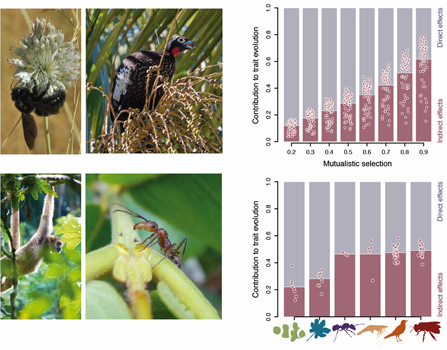The age of the internet has shown us the power of webs and networks. The internet and its users form webs, as do roads and cars, airport and planes, businesses within and among cities, and neurons within our bodies. The earth's millions of species also form webs as species prey on each other, parasitize each other, compete for food, and form mutualistic associations. It is all about webs. One of the major goals for ecologists and evolutionary biologists is to understand how webs of species form, how they change in participants over time, and how they affect evolution. When species interact with each other, they often do not just evolve, they coevolve. Natural selection favors predators that are better at capturing prey, and it favors prey that have better defenses for escaping predators. It favors individuals that compete better against other species. And, among mutualistic species, natural selection favors, for example, plants that are better at attracting pollinating insects and flower-visiting insects that are better at extracting pollen and nectar from flowers. Even describing the full pattern of connections within these webs is a daunting task. This study attempted to understand how species coevolve within large webs of mutualistic species. It began with a set of 75 webs of interacting species that other researchers had previously described from a wide range of terrestrial and marine environments. These webs included, for example, plants and pollinators, and plants and fruit-eating birds and mammals, and anemones and anemone fishes. Each web had, at one extreme, species that interact with only one other species and, at the other extreme, species that interact with many other species. When drawn as a network, each species is a node and each interaction between species is a line between two nodes. Each line is therefore a direct interaction between two species. Using these webs as a starting point, the authors developed a mathematical model that allowed them to explore for the first time how coevolution might shape the traits of species throughout complex webs of many interacting species. The problem to solve, though, is not just how traits of species are shaped by direct coevolution between pairs of species. Rather, the problem to solve is how coevolution shapes species that interact both directly and indirectly. If two species interact and coevolve with each other, then their coevolution, in turn, could indirectly affect the future evolution of other species within the web. The authors studied the relative effects of direct and indirect coevolution on the evolution of traits within webs of different shapes. Their analyses suggested two counterintuitive results. First, the stronger the importance of coevolutionary selection between partners, the greater the importance of indirect effects on overall evolution throughout the network. Second, in mutualisms involving multiple partners, the most specialized species—those species with the fewest direct partners—are more influenced by indirect effects than by their direct partners. These two results, together with others, have many implications for our understanding of evolution and coevolution within webs of interacting species. Among the most important, though, are two conclusions that link evolution, coevolution, and the rate of environmental change. With slow environmental change, the indirect effects of species on the evolution of other species may help mutualistic interactions persist over long periods of time. In contrast, rapid environmental change may slow the overall rate of evolution driven by direct interactions within large networks, making each species more vulnerable to extinction. With rapid environmental change, then, environments may change faster than species can adapt within large mutualistic networks. The problem of direct and indirect effects within networks is not unique to biology, of course. How to study indirect effects within webs has troubled scientists in physics, engineering, computer science, and other disciplines. The modeling framework developed here is applicable to many types of networks. Starting from what may seem as simple descriptions of who interacts with whom, this study gives us insights into how evolution and coevolution may shape the fascinating complexity of the web of life. informacion[at]ebd.csic.es: Guimarães et al (2017) Indirect effects drive coevolution in mutualistic networks. Nature doi:10.1038/nature24273


 Las altas temperaturas están provocando que las lagunas y las marismas de Doñana pierdan agua rápidamente
Las altas temperaturas están provocando que las lagunas y las marismas de Doñana pierdan agua rápidamente




